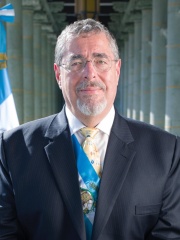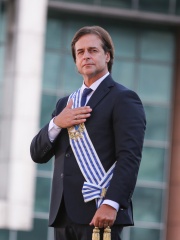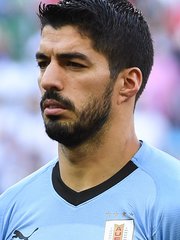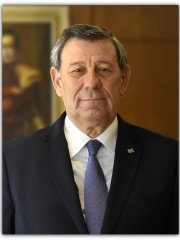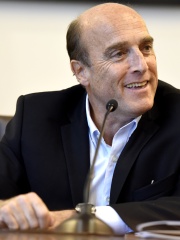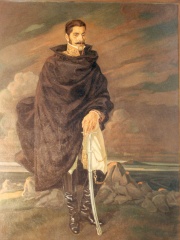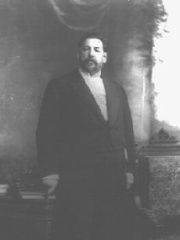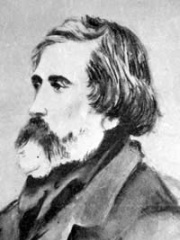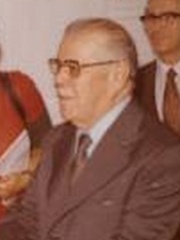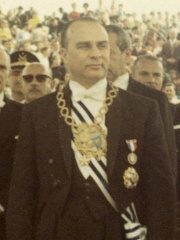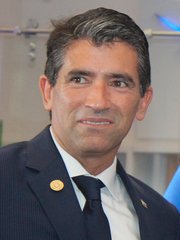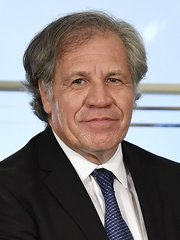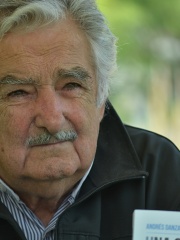
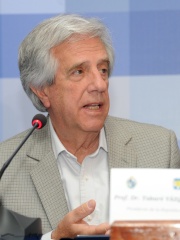
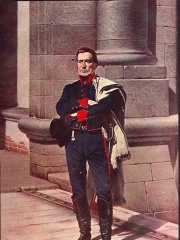
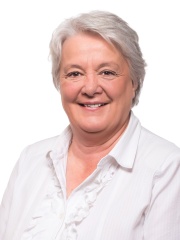
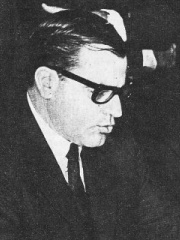

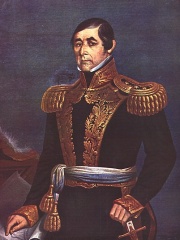
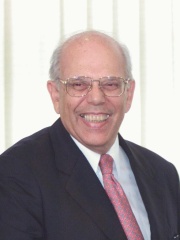
The Most Famous
POLITICIANS from Uruguay
This page contains a list of the greatest Uruguayan Politicians. The pantheon dataset contains 19,576 Politicians, 61 of which were born in Uruguay. This makes Uruguay the birth place of the 57th most number of Politicians behind Latvia, and Morocco.
Top 10
The following people are considered by Pantheon to be the top 10 most legendary Uruguayan Politicians of all time. This list of famous Uruguayan Politicians is sorted by HPI (Historical Popularity Index), a metric that aggregates information on a biography's online popularity. Visit the rankings page to view the entire list of Uruguayan Politicians.

1. José Mujica (1935 - 2025)
With an HPI of 82.11, José Mujica is the most famous Uruguayan Politician. His biography has been translated into 91 different languages on wikipedia.
José Alberto "Pepe" Mujica Cordano (20 May 1935 – 13 May 2025) was a Uruguayan politician, revolutionary and farmer who served as the 40th president of Uruguay from 2010 to 2015. A former guerrilla with the Tupamaros, he was tortured and imprisoned for 14 years during the military dictatorship in the 1970s and 1980s. A member of the Broad Front coalition of left-wing parties, Mujica was the minister of Livestock, Agriculture, and Fisheries from 2005 to 2008 and a senator afterwards. As the candidate of the Broad Front, he won the 2009 presidential election and took office as president on 1 March 2010. Mujica's administration implemented a range of progressive policies, including the decriminalization of abortion, the legalization of marijuana consumption and the legalization of same-sex marriage. Additional measures strengthened the country's trade unions and significantly bolstered minimum wages. While in office, Mujica was described as being "the world's poorest president" due to his austere lifestyle and his donation of around 90 percent of his US$12,000 monthly salary to charities that support low-income individuals and small entrepreneurs. He was an outspoken critic of capitalism's focus on stockpiling material possessions which do not contribute to human happiness.

2. Tabaré Vázquez (1940 - 2020)
With an HPI of 74.39, Tabaré Vázquez is the 2nd most famous Uruguayan Politician. His biography has been translated into 67 different languages.
Tabaré Ramón Vázquez Rosas (Spanish pronunciation: [taβaˈɾe raˈmom ˈbaskes ˈrosas]; 17 January 1940 – 6 December 2020) was a Uruguayan politician and oncologist who served as the 39th and 41st President of Uruguay from 2005 to 2010 and from 2015 to 2020. During his political career, Vázquez was a member of the Broad Front coalition. Before his first presidential term, Vázquez was president of the Club Progreso team and made two unsuccessful presidential bids in 1994 and 1999. He served as Intendant of Montevideo between 1990 and 1994 shortly before his first presidential campaign. Vázquez was first elected president on 31 October 2004 and took office on 1 March 2005. He was the first socialist president of the country. His first presidency was remembered for his diplomatic relationships with Brazil and Argentina while being criticized by his party over his anti-abortion views. He strengthened the unions and improved Uruguay's social services. After leaving the presidency in 2010, Vázquez successfully ran for a second term in 2014. After leaving office for a second time in March 2020, he later died of lung cancer in December of that year at the age of 80.

3. José Gervasio Artigas (1764 - 1850)
With an HPI of 68.01, José Gervasio Artigas is the 3rd most famous Uruguayan Politician. His biography has been translated into 42 different languages.
José Gervasio Artigas Arnal (Spanish pronunciation: [xoˈse xeɾˈβa.sjo aɾˈti.ɣas aɾˈnal]; June 19, 1764 – September 23, 1850) was a soldier and statesman who is regarded as a national hero in Uruguay and the father of Uruguayan nationhood. Born in Montevideo, Artigas enlisted in the Spanish military in 1797 and fought the British in the Anglo-Spanish War. At the outbreak of the Spanish-American wars of independence, Artigas supported the Primera Junta in Buenos Aires against Spain. He defeated the Spanish royalists at Las Piedras and laid siege to Montevideo, but was forced to withdraw in the face of Portuguese intervention. Artigas subsequently broke with the centralist government of Buenos Aires and took over Montevideo in 1815. He then oversaw the creation of the Federal League, an alliance of six provinces under a federal style of government. In 1816, the United Kingdom of Portugal, Brazil and the Algarves invaded the Banda Oriental, eventually annexing it as a province. Artigas was driven into Paraguay, where he lived in exile until his death in 1850.

4. Lucía Topolansky (b. 1944)
With an HPI of 65.74, Lucía Topolansky is the 4th most famous Uruguayan Politician. Her biography has been translated into 19 different languages.
Lucía Topolansky Saavedra (born 25 September 1944) is a Uruguayan politician and former revolutionary who served as the 17th vice president of Uruguay from September 2017 to March 2020. A member of the Movement of Popular Participation (MPP) — Broad Front, she also served as Senator of the Republic from 2020 to 2022 and from 2005 to 2017, as National Representative from 2000 to 2005 and as First Lady of Uruguay as the wife of president José Mujica from 2010 to 2015. Raised in an upper-class family, in 1969 Topolansky joined the far-left guerrilla group Tupamaros and went underground. In 1985, due to the amnesty law, she was released and participated in the founding of the MPP, starting her political career. In 1995 she was elected as a member of the Montevideo legislature, and in 2004 she was elected as a substitute National Representative, assuming the seat after the death of the incumbent Jorge Quartino. However, she took over as Senator of the Republic, as she was the first substitute for her husband José Mujica who left the seat to take office as Minister of Livestock, Agriculture and Fisheries in 2005. She was a candidate for Intendant of Montevideo in the 2015 municipal elections, being defeated by Daniel Martínez Villamil. In September 2017, she took office as Vice President of Uruguay after the resignation of Raúl Sendic Rodríguez, becoming the first woman to hold the position.
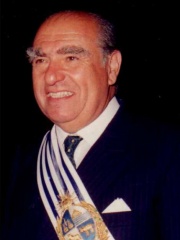
5. Julio María Sanguinetti (b. 1936)
With an HPI of 65.72, Julio María Sanguinetti is the 5th most famous Uruguayan Politician. His biography has been translated into 39 different languages.
Julio María Sanguinetti Coirolo (Spanish pronunciation: [ˈxuljo maˈɾia saŋɡiˈneti kojˈɾolo]; born 6 January 1936) often known by his initials JMS, is a Uruguayan former lawyer, journalist and politician of the Colorado Party (PC) who served as the President of Uruguay as the 35th president from 1985 to 1990, and again as the 37th president from 1995 to 2000. He was the first democratically elected president after twelve years of military dictatorship. Born in Montevideo, Sanguinetti graduated from the University of the Republic in 1961 with a law degree. He later combined his legal practice with work as a journalist. He had already been writing for the press, first in the weekly Canelones and later, since 1955, as a columnist for Acción, a newspaper established by the then-President, Luis Batlle Berres, for which he covered events such as the Cuban Revolution and the OAS Foreign Ministers' summit that censured Cuba for its decision to establish relations with the Soviet Union. In the 1962 general election, Sanguinetti was elected National Representative for the Montevideo Department, and re-elected in 1966. In 1969 the then president Jorge Pacheco Areco appointed him Minister of Industry and Commerce. From March to October 1972 he served as Minister of Education and Culture under Juan María Bordaberry. He publicly opposed the 1973 coup d'état and the subsequent civil-military dictatorship. Sanguinetti participated in the Naval Club Pact that made the democratic transition possible. In the 1984 general election he was elected President of Uruguay as the most voted candidate of the most voted political party, according to the Ley de Lemas system. Major government initiatives he undertook during his first term consisted of measures to disarm the previous regime, and included an amnesty law in favor of people who were still detained, convicted by military justice for political crimes and the Law on the Expiration of the Punitive Claims of the State. In foreign policy, Sanguinetti's government recognized and established diplomatic relations with the People's Republic of China, and signed the Alvorada Act, which added Uruguay to the regional integration process, which later led to the creation of the Southern Common Market.

6. Juan María Bordaberry (1928 - 2011)
With an HPI of 65.03, Juan María Bordaberry is the 6th most famous Uruguayan Politician. His biography has been translated into 34 different languages.
Juan María Bordaberry Arocena (Spanish: [boɾðaβeˈri aɾoˈsena]; 17 June 1928 – 17 July 2011), was an Uruguayan politician and cattle rancher who served as the 34th President of Uruguay from 1972 until his ouster in 1976. For the last three years of his tenure, he was the first President of the Civic-Military Dictatorship. Previously, he was the Minister of Agriculture from 1969 to 1972. He came to office following the Presidential elections of late 1971. In 1973, Bordaberry engineered a self-coup where he dissolved the General Assembly and transferred its powers to a military-influenced Council of State. He then ruled by decree as a military-sponsored dictator until disagreements with the military led to his being overthrown before his original term of office had expired. On 17 November 2006, Bordaberry was arrested in a case involving four deaths, including two of members of the General Assembly during the period of civilian-military rule in the 1970s.

7. Luis Alberto Lacalle (b. 1941)
With an HPI of 64.48, Luis Alberto Lacalle is the 7th most famous Uruguayan Politician. His biography has been translated into 35 different languages.
Luis Alberto Lacalle de Herrera (Spanish pronunciation: [ˈlwis alˈβeɾto laˈkaʝe ðe eˈreɾa]; Lacalle locally [laˈkaʒe] or [laˈkaʃe]; born 13 July 1941) is a Uruguayan politician and lawyer who served as the 36th president of Uruguay from 1990 to 1995. A member of the National Party, he previously served as National Representative from 1972 to 1973, and as Senator of the Republic from 1985 to 1990. Lacalle was born and raised in Montevideo. He is the grandson of Luis Alberto de Herrera who led the National Party and founded one of its most prominent sectors. He attended the Jesuit Colegio Seminario and graduated from the University of the Republic in 1964 with a law degree. In his youth he worked as a journalist in some media outlets. From 1972 to 1973 he served as National Representative for the Montevideo Department, but lost his seat after the dissolution of parliament with the coup d'état carried out by President Juan María Bordaberry. Lacalle was elected president in the 1989 election, which marked only the third time since 1860 that his party had won a national election. It had last led the government when it formed a majority on the National Council of Government from 1959 to 1967, and last held the presidency via Bernardo Prudencio Berro from 1860 to 1865. His presidency was characterized by a liberal economic policy in line with the Washington Consensus. He carried out a fiscal adjustment and a reform to state-owned companies to deregulate them. This earned him opposition from the left and the union movement. In foreign policy, the Lacalle government signed the Treaty of Asunción that established the Southern Common Market (MERCOSUR). After leaving office in 1995, Lacalle continued in active politics. In 1999 he ran for president again, finishing in third place. In 2004 he ran in the National Party presidential primaries, but was defeated by Jorge Larrañaga, who was the party's candidate in the general election. In 2009 he was a presidential candidate again but was defeated in the second round by the Broad Front nominee, José Mujica, who was elected president. With the victory of his son, Luis Lacalle Pou, in the 2019 general election, the two became the third father–son pair to serve as the nation's president.

8. Fructuoso Rivera (1784 - 1854)
With an HPI of 64.43, Fructuoso Rivera is the 8th most famous Uruguayan Politician. His biography has been translated into 32 different languages.
José Fructuoso Rivera y Toscana (17 October 1784 – 13 January 1854) was a Uruguayan general and patriot who fought for the liberation of Banda Oriental from Brazilian rule, thrice served as President of Uruguay and was one of the instigators of the long Uruguayan Civil War. He is also considered to be the founder of the Colorado Party, which ruled Uruguay without interruption from 1865 until 1958. He made a controversial decision to almost completely eliminate the native Charrúa during the 1831 Massacre of Salsipuedes.

9. Jorge Batlle (1927 - 2016)
With an HPI of 63.97, Jorge Batlle is the 9th most famous Uruguayan Politician. His biography has been translated into 40 different languages.
Jorge Luis Batlle Ibáñez (Spanish pronunciation: [ˈxoɾxe ˈlwis ˈbaʝe iˈβaɲes]; Batlle locally [ˈbaʒe] or [ˈbaʃe]; 25 October 1927 – 24 October 2016) was an Uruguayan politician and lawyer, who served as the 38th president of Uruguay from 2000 to 2005. A member of the Colorado Party, he previously served as National Representative from 1959 to 1967, and as Senator of the Republic from 1985 to 1990 and from 1990 to 1999. Batlle is, to date, the last president from the Colorado Party. The eldest son of the 30th president Luis Batlle Berres and a member of the Batlle family, he was the fourth member of the family to serve as president of the country. He graduated from the University of the Republic in 1959 with a law degree, and then began a career as a journalist in El Día newspaper. He began his political career in the 1950s, being elected National Representative in the 1958 general election. During the civil-military dictatorship he was banned and in the 1984 general election that led to the democratic transition he was prevented from running for president, he could only run for the Senate. His presidency was marked by the worsening of a banking crisis and a foot-and-mouth epidemic that affected the country's economy. Some of his initiatives consisted of the creation of the Comisión para la Paz (Spanish for 'Commission for Peace'), an investigative body on human rights with the purpose of determining the situation of those detained-disappeared during the civil-military dictatorship. In foreign policy, Batlle's government strengthened Uruguay's ties with the United States and broke diplomatic relations with Cuba.
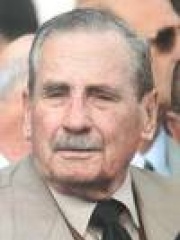
10. Gregorio Conrado Álvarez (1925 - 2016)
With an HPI of 63.41, Gregorio Conrado Álvarez is the 10th most famous Uruguayan Politician. His biography has been translated into 30 different languages.
Gregorio Conrado Álvarez Armelino (26 November 1925 – 28 December 2016), also known as El Goyo, was an Uruguayan Army general and dictator who served as president of Uruguay from 1981 until 1985. He was the last surviving president of the civic-military dictatorship.
People
Pantheon has 61 people classified as Uruguayan politicians born between 1764 and 1973. Of these 61, 14 (22.95%) of them are still alive today. The most famous living Uruguayan politicians include Lucía Topolansky, Julio María Sanguinetti, and Luis Alberto Lacalle. The most famous deceased Uruguayan politicians include José Mujica, Tabaré Vázquez, and José Gervasio Artigas. As of April 2024, 5 new Uruguayan politicians have been added to Pantheon including Yamandú Orsi, Carolina Cosse, and Beatriz Argimón.
Living Uruguayan Politicians
Go to all RankingsLucía Topolansky
1944 - Present
HPI: 65.74
Julio María Sanguinetti
1936 - Present
HPI: 65.72
Luis Alberto Lacalle
1941 - Present
HPI: 64.48
Bernardo Arévalo
1958 - Present
HPI: 62.18
Luis Lacalle Pou
1973 - Present
HPI: 59.95
Yamandú Orsi
1973 - Present
HPI: 58.49
Edgardo Codesal
1951 - Present
HPI: 55.83
Rodolfo Nin Novoa
1948 - Present
HPI: 52.09
Martín Vázquez
1969 - Present
HPI: 51.94
Carolina Cosse
1961 - Present
HPI: 51.94
Beatriz Argimón
1961 - Present
HPI: 49.52
Daniel Martínez
1957 - Present
HPI: 48.51
Deceased Uruguayan Politicians
Go to all RankingsJosé Mujica
1935 - 2025
HPI: 82.11
Tabaré Vázquez
1940 - 2020
HPI: 74.39
José Gervasio Artigas
1764 - 1850
HPI: 68.01
Juan María Bordaberry
1928 - 2011
HPI: 65.03
Fructuoso Rivera
1784 - 1854
HPI: 64.43
Jorge Batlle
1927 - 2016
HPI: 63.97
Gregorio Conrado Álvarez
1925 - 2016
HPI: 63.41
Manuel Oribe
1792 - 1857
HPI: 62.67
José Batlle y Ordóñez
1856 - 1929
HPI: 62.29
Venancio Flores
1808 - 1868
HPI: 62.14
Aparicio Méndez
1904 - 1988
HPI: 61.57
Jorge Pacheco Areco
1920 - 1998
HPI: 61.22
Newly Added Uruguayan Politicians (2025)
Go to all RankingsYamandú Orsi
1973 - Present
HPI: 58.49
Carolina Cosse
1961 - Present
HPI: 51.94
Beatriz Argimón
1961 - Present
HPI: 49.52
Raúl Fernando Sendic Rodríguez
1962 - Present
HPI: 48.06
Luis Almagro
1963 - Present
HPI: 47.06
Overlapping Lives
Which Politicians were alive at the same time? This visualization shows the lifespans of the 25 most globally memorable Politicians since 1700.

